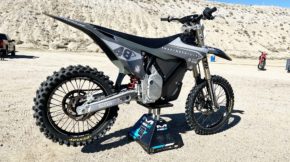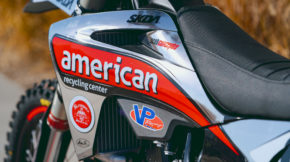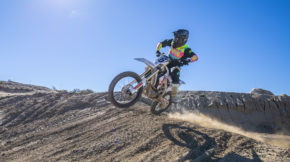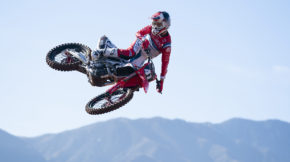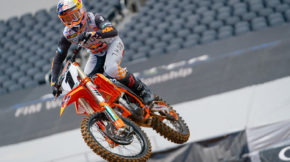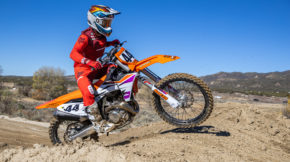Trail Tested | Specialized Turbo Kenevo Expert
Share
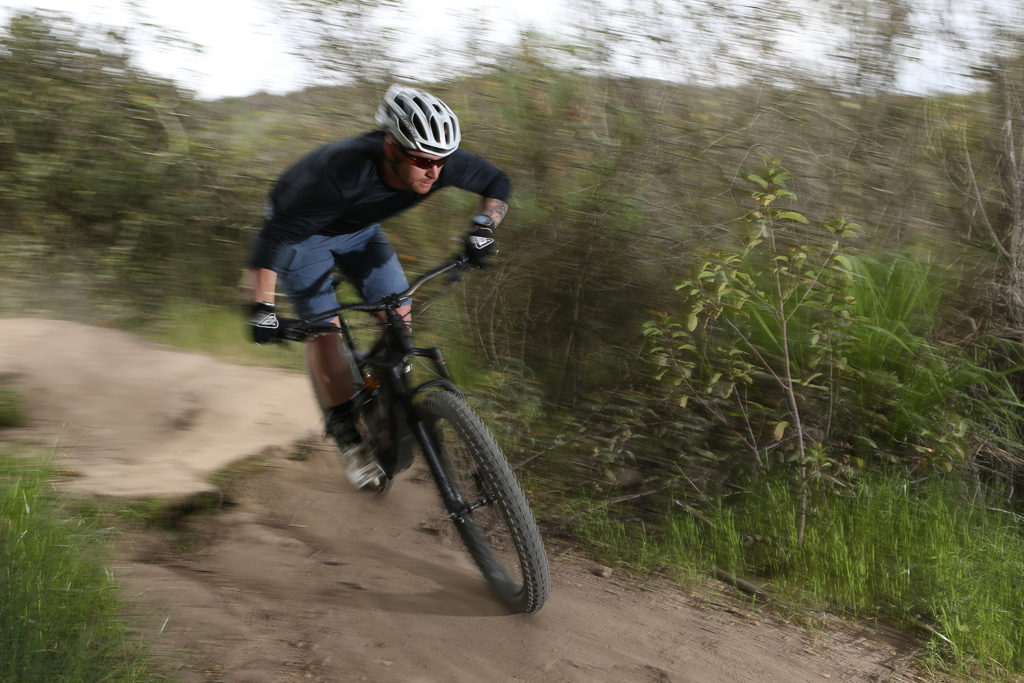
Ryan Villopoto puts the Specialized Turbo Kenevo through its paces.
Trail Tested | Specialized Turbo Kenevo Expert
In case you haven’t noticed, we’re big fans of pedal-assist mountain bikes at Swapmoto Live. Sure, we spend most of our time on conventional bikes, but pedal-assist is the biggest trend in cycling these days and resisting the movement is an exercise in futility. In addition to attracting new riders to the sport of mountain biking by enabling those who would otherwise be unfit to enjoy life on two wheels, pedal-assist bikes offer riders the ability to train in specific heart rate zones and even serve as a great recovery tool. Most of all, though, e-bikes are fun!
Specialized was the first major manufacturer to build a serious pedal-assist mountain bike from the ground up, with a chassis that was designed specifically around the battery and electric motor. The original Turbo Levo was introduced in 2016 and forever changed the way we thought about e-bikes with its sleek design and natural-feeling assist powerband. We’ll admit that we were skeptical when we took delivery of our first Levo test bike and didn’t have much interest in actually riding it at first but were quickly won over by the Levo.
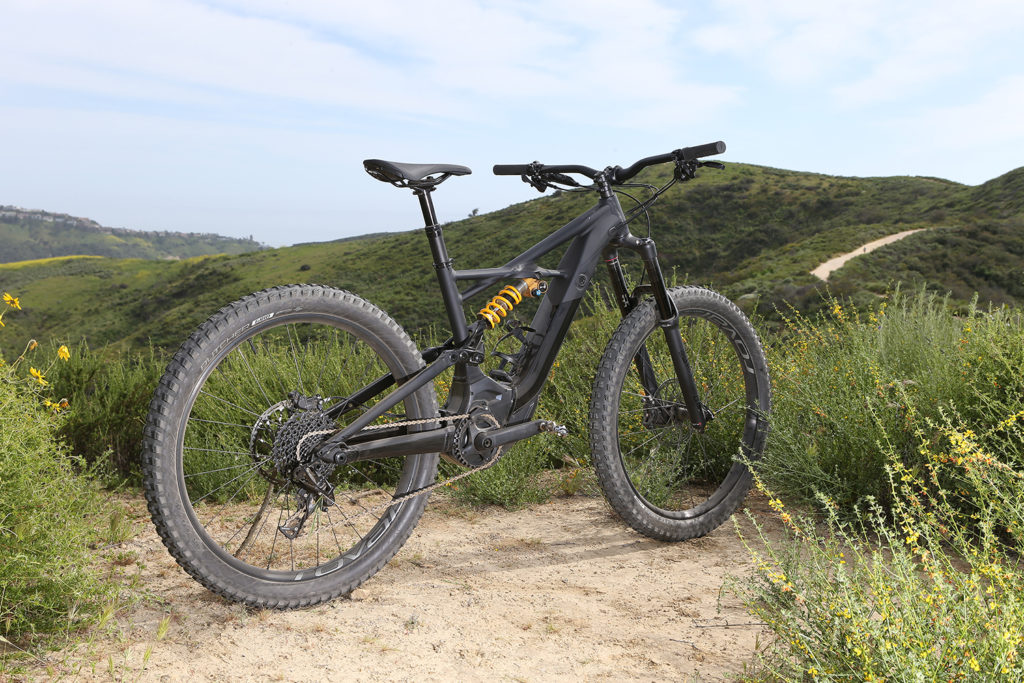
The Specialized Turbo Kenevo.
In 2018, Specialized introduced its second pedal-assist mountain bike; the Turbo Kenevo. While the original Levo was based on the popular Stumpjumper trail bike platform, the Kenevo is designed around the more-aggressive Enduro bike with has slack geometry and 180mm of suspension travel front and rear.
Power
The Kenevo is powered by a German-made Brose 1.3 motor that boasts a 15% power increase over the original Levo’s motor, and it is also more-efficient and has greater range. The battery is housed in the frame’s downtube, is easy to remove, and charges quickly through a port that’s located on the left side of the frame, just in front of the cranks. Unlike the original Levo, the Kenevo has a simple handlebar-mounted controller that allows you to toggle in between the three power settings: eco, trail, and turbo.
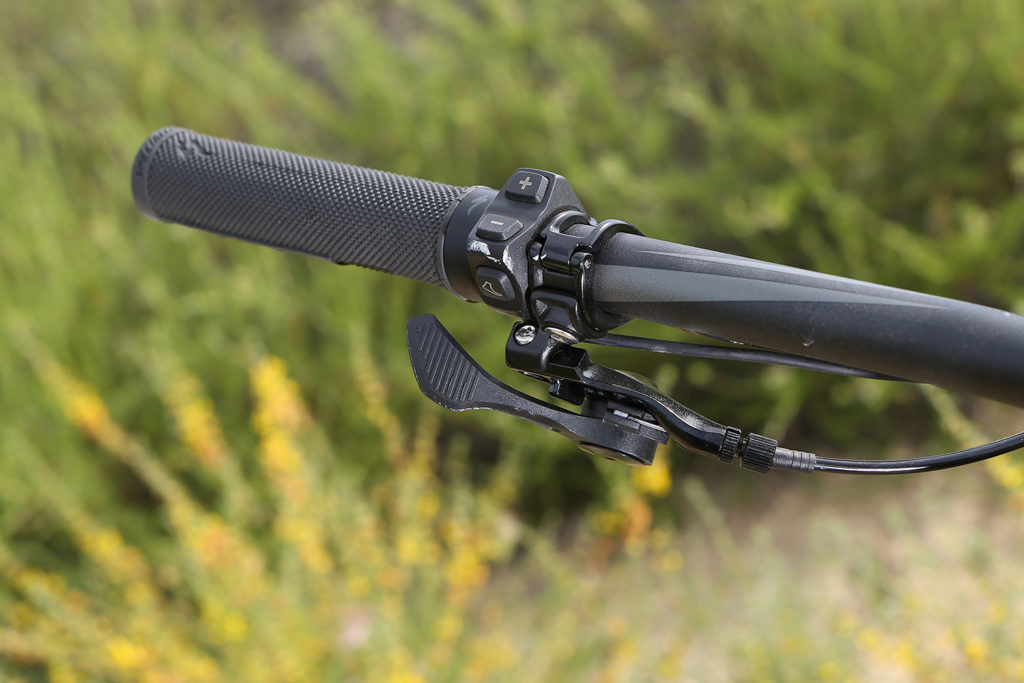
Four buttons are located on the left side of the handlebar.
Also, new on the Keveno is the walk button, which when depressed powers the bike forward at one mile per hour. This comes in especially handy when pushing the bike up steep trails that are too tricky to pedal up. The bike, after all, does weigh in at 53 pounds!
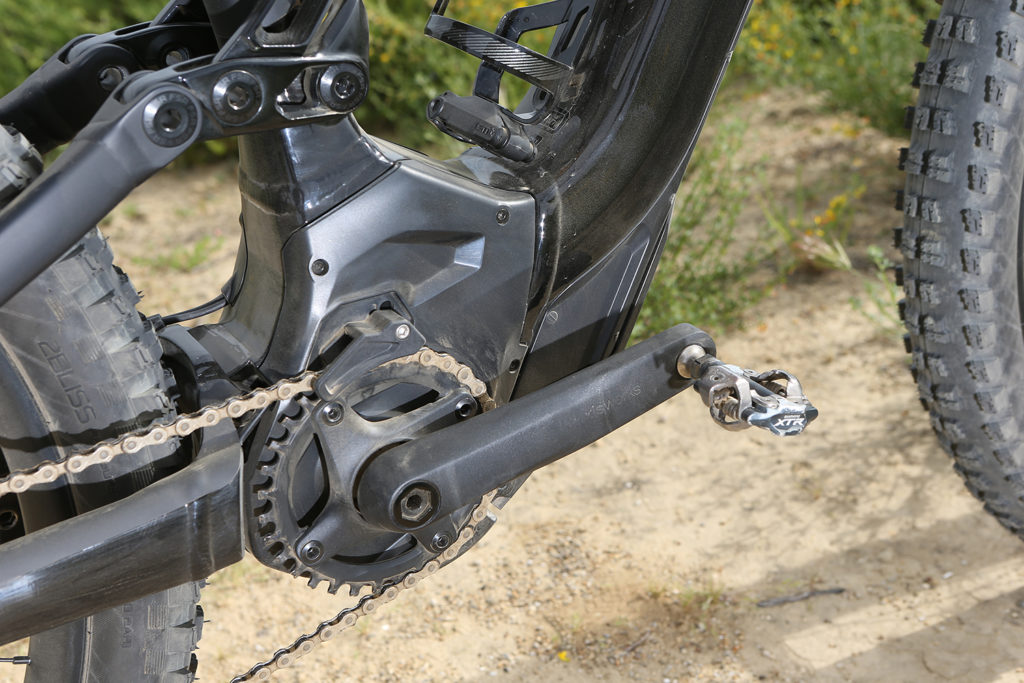
At the heart of the Turbo Kenevo is a super-smooth, quiet and controllable electric motor. It takes a sharp eye to notice the extra girth in the frame, as the Kenevo is sleek in appearance.
The combination of your pedal power and the engine assist is transferred to the wheels via an e-bike-specific SRAM drivetrain, the GXe lever delivering only one upshift or downshift per click to protect the derailleur from damage that can be caused my multiple shifts under an excessive load. The original Turbo Levo had a standard drivetrain and we found out quickly that multiple downshifts while attacking a steep section could quickly turn your rear derailleur into a pretzel. The SRAM PG-11 cassette offers a 11-42 spread to choose from when paired with the 32-tooth front chainring, and since the power assist cuts out at 20 mph this is more than enough gearing for the high end.
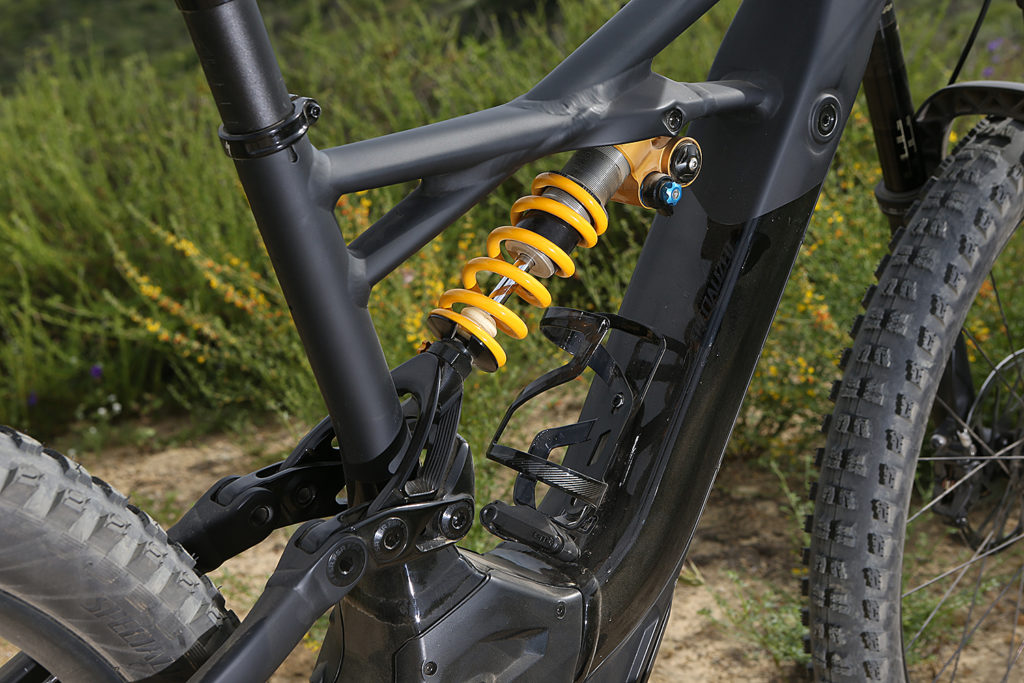
A beefy Ohlins coil spring shock and aggressive frame geometry that’s based on the Specialized Enduro bike make the Kenevo much more willing to get rowdy than the original Turbo Levo.
Suspension and Brakes
The most eye-catching thing about the Kenevo could very well be the Öhlins TTX Coil Spring shock. Paired with the Enduro-inspired frame geometry and the charger-cartridge-equipped RockShox Lyrik RCT3 fork, the bike is certainly equipped to handle some rowdy terrain…at speed. Thanks to the frame’s relaxed geometry, the stout suspension components, and the added girth of the bike for stability, the Kenevo is perhaps the most aggressive pedal-assist bike around.
Oversized 200mm SRAM Code-R brakes are aggressive and can haul the Kenevo down from speed with power and precision, while 38mm wide Roval wheels are mated to 2.8” Specialized Butcher Grid tires for extra grip and some added cushion.
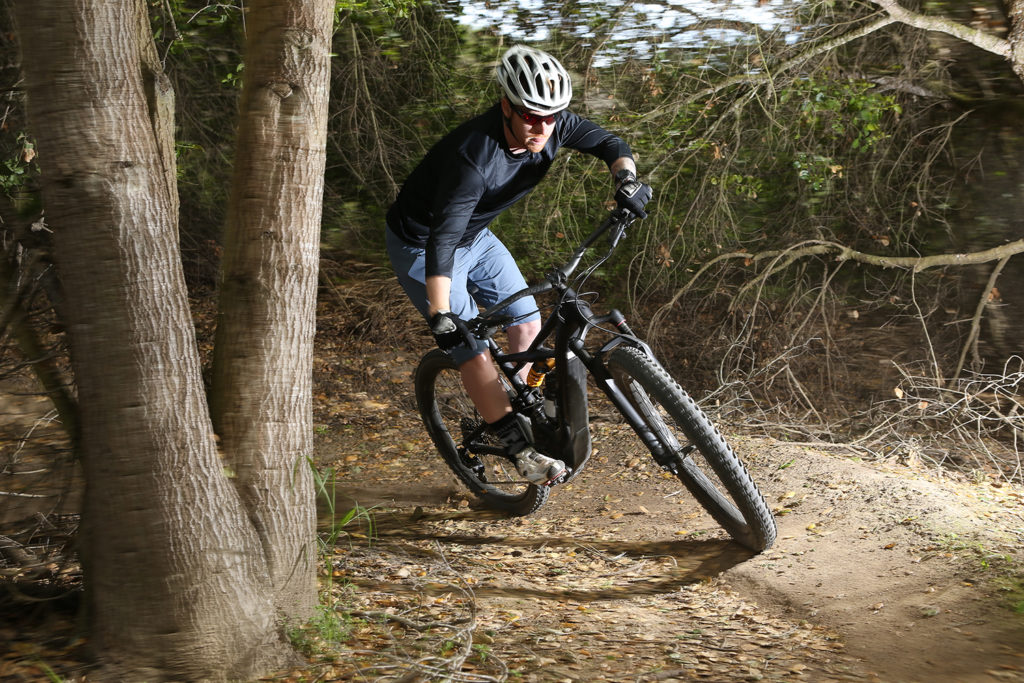 On the Trail
On the Trail
The first thing we noticed about the Kenevo on the trail is how big it feels. Compared to a same-sized Levo, the Kenevo definitely feels longer and taller, yet more stable and confidence inspiring. The slack geometry is not as nimble when climbing, but the bike inspires a ton of confidence when descending. The rougher the trail, the better. We really like the feel and tunability of the Ohlins coil spring shock. As dirt bike guys, the feel of an air shock feels a bit foreign when jumping due to their rebound character, but the coil spring of the Ohlins is smooth and predictable. Up front, the Rockshox Lyric fork proved to be plenty stout enough for the Kenevo’s girth, but in all honesty it is not the most comfortable fork we’ve ridden on. The fork feels a bit harsh in smaller impacts when we tuned it to absorb larger jumps and impacts, and too soft for said landings when we tuned it for comfort. Truth be told, a Fox front end may have been a better match in our opinion.
The plus-sized tires really do a lot for the confidence as they offer a ton of traction and have a more familiar feel for motocross riders than a skinny 2” tire would. Though we’ve heard some rumblings that the Butcher Grid tires are not substantial enough to hold up the weight of the Kenevo when ridden aggressively, we’ve encountered no shortcomings of the treads since going with a tubeless setup. The bike is delivered with inner tubes, and pinch flats are certainly in order the first time you take the bike into rocky sections. Save yourself the trailside trouble and go tubeless from the get-go.
Controlling the power settings while riding was a cinch, as the handlebar switch on the left side is easy to operate while riding. Power up and power down buttons are complemented by the aforementioned walk button that propels the bike forward at one mile per hour, as well as a turbo button that will kick the bike straight into the highest setting. Sure, this button eliminates one click on the power up button if you’re in eco, but we’re not sure it is really necessary. The bike is powered on and off by another set of buttons on the left side of the frames downtube, and the assist settings can also be adjusted there. We kind of wish the bike didn’t have the glowing green led display on the side of the frame…without them the bike might pass as a conventional ride with an exceptionally strong rider in the saddle! Haha!
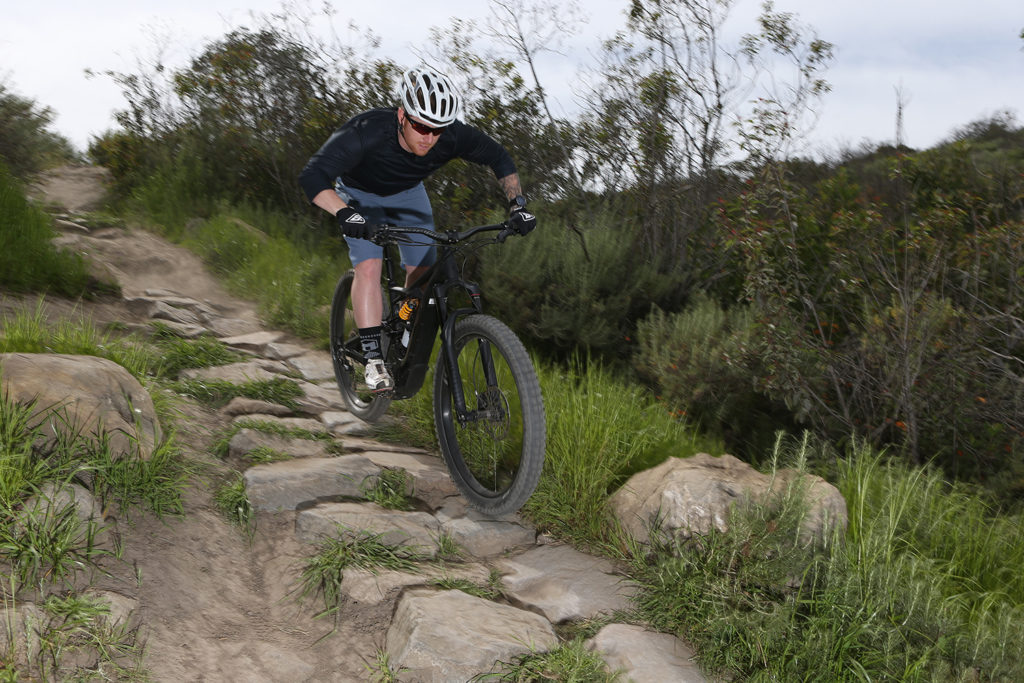 We were impressed with the stopping power of the SRAM brakes, but on longer, technical descents that require lots of braking, they will heat up and squeal. The Specialized Command Wu Post is unique in that the angle of the seat changes as the post compresses. You may have noticed the nose-high seat position that most downhill-specific bikes have – this is to allow maximum clearance for the rider while descending – and this is the angle that the Wu post assumes as it is compressed. To be transparent, we wish the bike came with a standard dropper post that maintains the flat seat setting. This, of course, is a matter of personal preference.
We were impressed with the stopping power of the SRAM brakes, but on longer, technical descents that require lots of braking, they will heat up and squeal. The Specialized Command Wu Post is unique in that the angle of the seat changes as the post compresses. You may have noticed the nose-high seat position that most downhill-specific bikes have – this is to allow maximum clearance for the rider while descending – and this is the angle that the Wu post assumes as it is compressed. To be transparent, we wish the bike came with a standard dropper post that maintains the flat seat setting. This, of course, is a matter of personal preference.
While we spent a couple solid weeks riding in as many areas as possible aboard the Specialized Turbo Kenevo loaned to us by Roy’s Cyclery in Upland, California, (909/982-8849 @royscyclery), we also spent some time riding with four-time Supercross Champion Ryan Villopoto, who recentyly took delivery of a Specialized Turbo Kenevo of his own. Because RV2 is a Specialized ambassador, we didn’t survey him for impressions about the bike, per se, but instead asked him what benefits he saw in pedal-assist mountain biking.
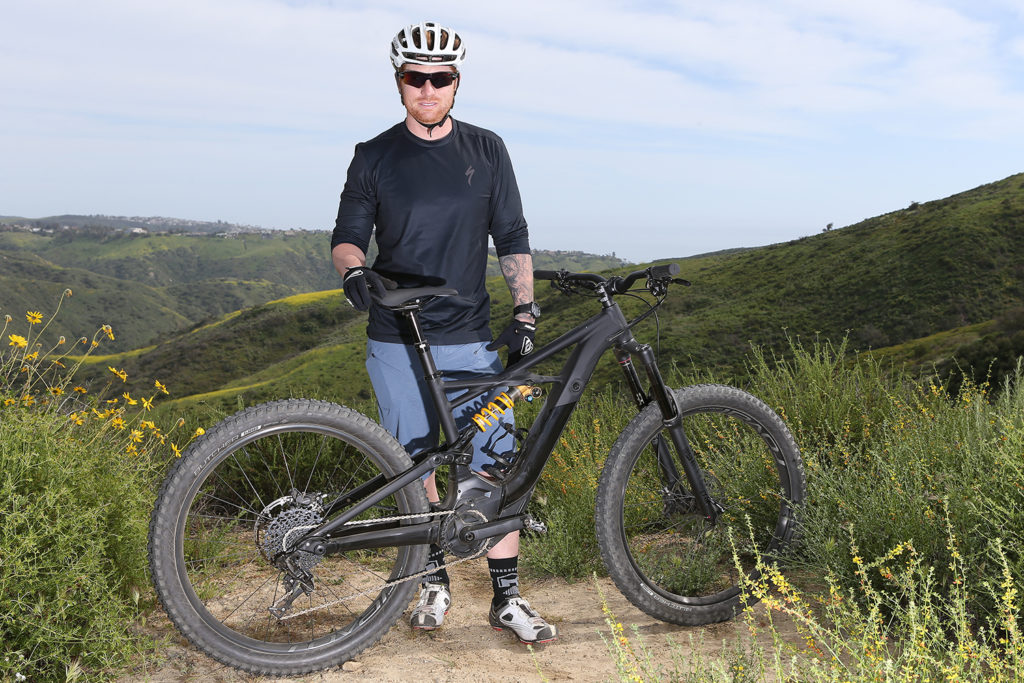
Four-time Supercross Champion Ryan Villopoto.
“I’ve been retired from racing for a few years now and there’s obviously no reason for me to kill myself training on a bicycle any longer,” he said. “But, for me, the Turbo Kenevo is a perfect bike because it still allows me to get out and get some exercise to try and burn some fat and stay reasonably healthy. (Laughs) People think that the bike does all the work for you and that is a complete misconception. Sure, you can put it in turbo mode and take advantage of the motor, but the eco and trail settings basically only make up for the weight of the bike and require you to work hard, too. I’ve been able to get my heart rate up where I want it with no problem. The Kenevo also allows me to go out and have a good time with my friends who are still training full time. It’s a pretty awesome bike, actually.”
SPECS 2018 SPECIALIZED TURBO KENEVO EXPERT 27.5
MSRP: $7000
Motor: Brose, 250W
Battery: Specialized M1-504, 504 Wh, integrated trail display, ANT+/Bluetooth module
Charge time: 4.5 hours
Top Assist Speed: 20 mph
Range: 20–40 miles, depending on conditions and power level
Drivetrain: SRAM GX, 1×11, 11-42T
Brakes: SRAM Code R hydraulic disc brakes, 200mm rotors front and rear
Fork: RockShox Lyrik, 180mm
Shock: Öhlins TTX22M, coil, 180mm
Frame: Multi-formed, aluminum alloy, 6061 T6, dual suspension, four-link all-mountain design/130mm travel.
Tires: 27.5×2.8” Butcher, Grid casing, 2Bliss Ready
Weight: 53 lb.

















